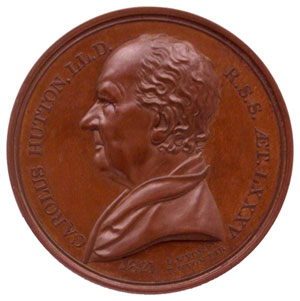As a calendar for the correspondence of a mathematician and professor of Mathematics at the Royal Military Academy enters our union catalogue, it is wonderful to watch the related contacts and networks extend our growing cluster of early modern mathematicians through the second half of the eighteenth century into the beginning of the nineteenth.

Charles Hutton, by Benjamin Wyon. 1823. Bronze medal. (© National Portrait Gallery, London; NPG 5783)
The son of a colliery overseer, Charles Hutton was born and brought up in Newcastle upon Tyne. Were it not for a childhood injury to one of his arms that led to a permanent disability, most probably he would have followed his forebears and siblings to work in the pit. Fortunately for subsequent mathematicians, however, Hutton was sent to school rather than to work and by his late teens had taken the place of his teacher in Jesmond. Hutton continued to establish himself and developed a focus on applied mathematics, in particular on navigation and surveying, and in 1779 he was awarded a doctorate at the University of Edinburgh and appointed Foreign Secretary of the Royal Society.
Hutton’s correspondence has been collated by Dr Benjamin Wardhaugh as part of his AHRC-funded work on Hutton. It is a rich catalogue, with people mentioned in the letters noted and many insightful abstracts provided. As Dr Wardhaugh remarks, while Hutton might be known best today for the opposition he encountered from Joseph Banks, the then president of the Royal Society, he emerged as the crucial focal point of a network of mathematicians in Georgian Britain.
Mathematical correspondence in EMLO is growing rapidly under the invaluable direction of Dr Philip Beeley, and many more early modern mathematicians are on course to join this particular circle in the coming months. For the present, however, we wish Dr Wardhaugh and Dr Beeley well as they embark upon their new and fascinating project, Reading Euclid: Euclid’s Elements of Geometry and its reception in Britain and Ireland, 1570-1700.
